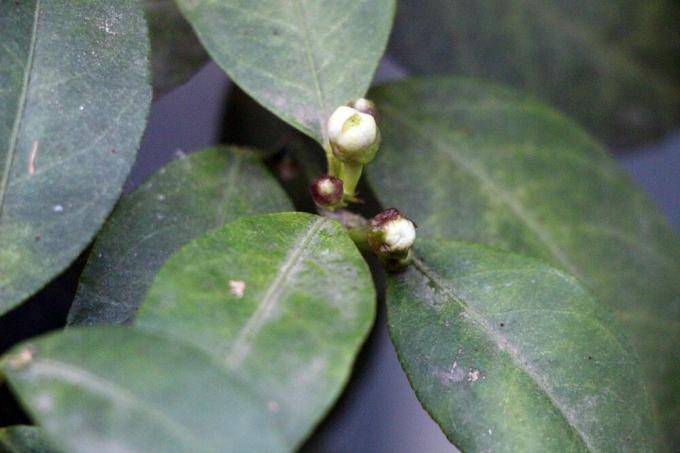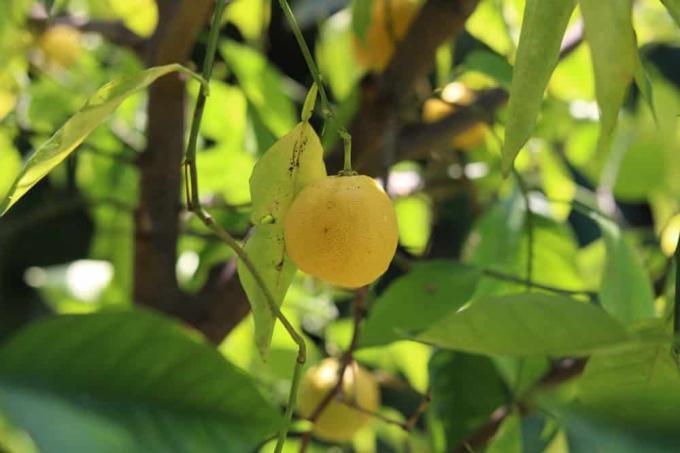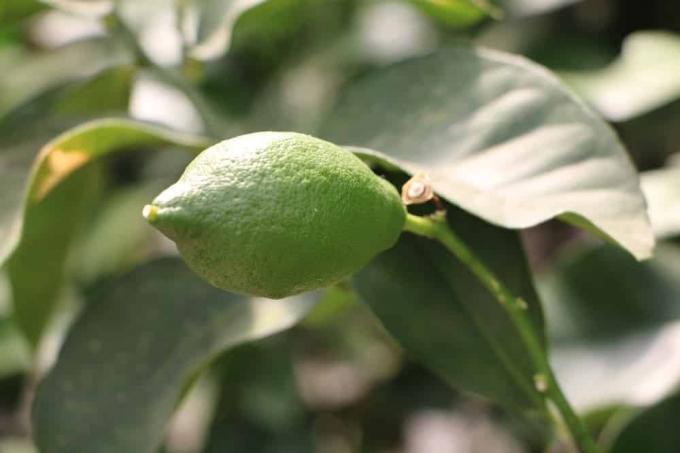

Table of contents
- Location
- plant substrate
- Planting – step by step:
- repot
- Pour
- Fertilize
- Cut
- hibernate
- The cold hibernation
- The warm hibernation
- multiply
- Sowing – step by step:
- Diseases & Pests
- When can I harvest the first lemons?
- How old can my lemon tree get?
- How big does the lemon tree get?
A lemon tree, widespread in the Mediterranean, provides a Mediterranean flair on many a terrace and many balconies. So that you can enjoy your tree for many years, it is best to find out about its needs and preferences before you buy it. Then the care is no longer so difficult and the joy of the first fruits is all the greater.
Location
Your lemon tree likes it sunny and warm. It needs at least eight hours of sun a day to thrive. Neither wind nor too much shade promote its growth and well-being. The lemon tree is then relatively susceptible to diseases or pests and only grows poorly. He usually feels very comfortable on a sheltered balcony.
Tip:
The lemon tree is not hardy and quite susceptible to pest infestation. Only buy it if you can offer it a sunny spot in summer and suitable winter quarters.
plant substrate
The soil should be rich in nutrients and deep, while being neutral or slightly basic. You will probably not plant your lemon tree outdoors because it is not hardy. But the substrate should also be well drained in the plant pot or tub. It is best to use special citrus soil, never loamy garden soil. If the substrate is too firm, the roots of your lemon tree cannot develop optimally and water absorption is made more difficult. Dry damage could then be the result.
Planting – step by step:
- Choose a plant pot about 2 to 3 cm larger than the root ball
- if not available: drill a drain hole
- Create a drainage layer: old potsherds or large pebbles
- Fill the pot with some well-drained soil
- it is best to use special citrus soil
- Insert lemon tree
- Fill pot with soil
- Press the soil down well
- water well
- It is best not to place them in the blazing sun until they have rooted
Use rather heavy vessels, for example made of clay or ceramic, for both planting and repotting. Then your lemon won't tip over so quickly, even if it's windy. Light (plastic) containers can be weighed down with a few stones.
repot
The lemon does not like to be repotted and takes root poorly. Therefore, you should only consider this if the lemon tree's pot is too small or if you suspect the tree's roots are rotting. A young lemon tree can then be repotted about every two to three years. If it grows more slowly later, then only repot it after five to ten years.

Make sure that you damage the sensitive roots of the lemon tree as little as possible when repotting. Remove any rotten and/or soft root parts. You can also carefully cut back the outermost roots of the ball a little. This encourages the lemon tree to form new roots. However, if large parts of the root ball are rotten or you cut them off because the tree would otherwise not fit in the pot, then your lemon will probably not survive.
Pour
Lemon trees are quite thirsty, especially when they are in the sun in summer. Water at the latest when the top layer of soil has dried slightly. Ideally, you should always water in the early morning or late afternoon, never in the blazing midday sun. So that your lemon tree really gets enough water, you should always water it thoroughly. Give it enough water so that some of it runs out of the bottom of the planter. So you can be sure that the bale is well watered. However, the lemon does not tolerate waterlogging, so excess water should always be able to drain off easily and, if necessary, be removed from the cachepot. It is often recommended not to use chalky tap water to water citrus plants, but the opposite is true. Calcareous water ensures a good supply of calcium.
Fertilize
You should give the lemon regular fertilizer every one to two weeks during the growing season. You have the choice between commercially available liquid fertilizer or a special fertilizer for citrus plants. The latter is particularly well suited to the needs of your lemon tree. Mix some humus under the soil when repotting or use citrus soil, then the lemon will not need any further fertilizer for a few weeks. It is also important to remember that too much fertilizer does more harm than good. This can easily lead to brown leaf edges or chlorosis. This “yellowing disease” causes the leaves of your lemon tree to turn yellow. This is due to an oversupply or imbalance of nutrients. When using citrus fertilizer and calcareous irrigation water, chlorosis should not occur.
Cut
A pruning of the lemon tree should always be carried out very carefully and moderately. It takes a long time for gross cutting errors to “grow out”. However, you are allowed to cut the tree into shape. You should remove diseased or dead branches as well as damaged or cross-growing twigs. Let the crown become a little lighter towards the inside, then the leaves and fruits will also be supplied with sufficient light there.

The ideal time for pruning the lemon tree depends on the age of the tree and the space available in the winter quarters. Young trees should be pruned in spring before they sprout. This can happen both in spring and in autumn. When pruned in autumn, the tree requires less space in the winter quarters. If an older lemon tree tends to bare, then a somewhat more vigorous pruning in late summer is the order of the day.
hibernate
In the garden, a lemon tree can at best overwinter in a mild area if it freezes only rarely and for a maximum of a short time. Even then it is advisable to bring the tree to a sheltered place. Above all, icy wind and/or wet and cold weather can damage the tree. If your lemon tree is to go into winter quarters, you have the choice between two different options: cold and warm hibernation.
No matter which form you choose, you can slowly stop fertilizing as early as August. Check regularly in the winter quarters whether the plant is getting enough water, the bale should not dry out completely. Before you bring the sapling back outside, slowly acclimate it to the sun again.
The cold hibernation
For the cold hibernation you need a cool place with temperatures of 5° to a maximum of 10°C. It doesn't have to be bright here either. However, the tree then loses its leaves. However, it will sprout again in the spring. In cool quarters you should only water the lemon tree a little. However, do not suddenly reduce the watering amount when moving to the winter quarters, but slowly reduce the watering amount beforehand.
The warm hibernation
The "warm" hibernation should be carried out in light and only moderately warm. Keep in mind that your lemon tree will then also need more water. Only reduce the watering amount in the winter quarters and only slightly. Check the substrate regularly for waterlogging. Dry heating air promotes the occurrence of pests in many plants. Therefore, the lemon should not hibernate too warm and with sufficient humidity. Set up a humidifier if necessary.
multiply

You can propagate your lemon trees by seed or with the help of cuttings. However, since these cuttings do not always root reliably, you should always plant several. Sowing is relatively easy, but harvesting is only possible after many years. If you want to grow lemons on your windowsill at home, you can do this all year round.
Sowing – step by step:
- Sowing on a nutrient-poor substrate (coconut fibers or soil-sand mixture)
- seeds approx. Press in 2 cm deep
- Keep substrate evenly moist
- avoid direct sunlight
- Germination time at approx. 18°C: 3 to 6 weeks
- Prick out seedlings when they are 10 cm tall
- get used to direct sunlight slowly
- propagation of cuttings:
- cut cuttings in early spring, approx. 20cm long
- remove lower leaves
- Place rubs in water, warm and in indirect sunlight
- Rooting after about 3 to 4 months
- Plant cuttings individually
- cut back carefully after about a year (encourages bushy growth)
Diseases & Pests
If you take good care of your lemon tree in a bright and warm place, then no diseases or pests should actually occur. However, due to mistakes in care, chlorosis or yellowing disease sometimes occurs, as well as root rot. The plant can usually be saved by quickly correcting the error.
pests
that can occur with the lemon:
- aphids
- miner fly
- vine weevil
- scale insects
- spider mites
By increasing the humidity and using home remedies, most pests can be controlled relatively well. With a low infestation, collecting the small animals is often enough.
When can I harvest the first lemons?

In the Mediterranean region, where the lemon is at home, a tree bears its first fruit when it is five to seven years old. With a self-grown tree, it takes much longer, if it comes to that at all. Because lemon trees sometimes also bear "barren" fruit. A tree can be grown from its core, but it will not bear any fruit. Ideally, however, you can expect the first lemons from a cutting after about seven or eight years. Trees grown from seed take about 10 to 15 years to produce their first fruit.
How old can my lemon tree get?
In nature, a lemon tree can live for over 100 years under optimal conditions. However, you should not expect such a long lifespan in your garden. But if you take good care of it, your lemon tree can live to be around 50 years old.
How big does the lemon tree get?
The maximum final size of a lemon tree depends on various factors, most notably the species or variety. This is how the real lemon tree (bot. Citrus Limon) a height of up to seven meters. In the bucket you can expect a size of about two to five meters, depending on:
- Pot size (may limit root growth)
- hours of sunshine per day
- appropriate care (sufficient water and nutrients)
 garden editorial
garden editorial I write about everything that interests me in my garden.
Learn more about potted plants

Abalie, Abelia grandiflora: 14 tips for proper care
The large-flowered abalia (Abelia grandiflora) is an extraordinarily easy-care ornamental shrub that delights with numerous funnel-shaped and subtly scented flowers. It is just as suitable as a background plant as a hedge or container plant.

Caring for the tangerine tree properly | 13 tips for the tangerine tree
Many citrus plants have evolved from the tangerine, one of the oldest and most original citrus species. With its white flowers and orange fruits, it is a feast for the eyes and the palate. In this country it is only cultivated as a container plant due to its sensitivity to frost.

Indian canna, Canna indica | 13 tips for care
Canna indica, also known by the botanical name Canna indica, is a decorative plant that not only enriches every garden during flowering. In pot culture, it can be used as an accent for many years thanks to its color and growth.

11 absolutely hardy container plants
Absolutely hardy potted plants have several advantages to offer, because they can remain outdoors even when the temperature is below zero and require little protection. If they are also evergreen, they can also bring joy all year round.

Is dwarf bamboo hardy? | 11 tips for care & cutting
Dwarf bamboo is one of the easy-care sweet grasses. In the garden, it can be used as a good ground cover, as it does not grow as tall as its larger relatives. Whether the plant is hardy and how it is cared for and cut can be read in the guide.

Pink dwarf banana, Musa velutina | Care of the Kenya Banana
The pink dwarf banana (Musa velutina) is an eye-catcher in the garden. It grows to a maximum of two meters and impresses with its impressive flowers. The small pink fruits taste sweet and aromatic. If you want to harvest the exotic fruits, you should follow our care tips.


